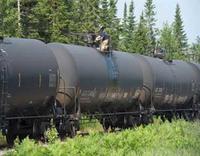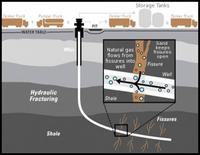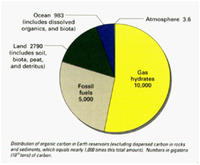-
Algae biofuel can help meet world energy demand
Microalgae-based biofuel not only has the potential to quench a sizable chunk of the world’s energy demands, researchers say. Microalgae produces much higher yields of fuel-producing biomass than other traditional fuel feedstocks and it does not compete with food crops. The researchers say that algae yields about 2,500 gallons of biofuel per acre per year. In contrast, soybeans yield approximately forty-eight gallons; corn about eighteen gallons.
-
-
Floating solar power plants offer many benefits
Water-based solar plants are at least 50 percent more efficient than a land-based solar power system.The water on which the plant floats helps extending the life of the photovoltaic panels, meaning greater efficiency and performance from the solar panel system, and the plant also prevents nearly 90 percent of the evaporation for the surface area that it covers, an important benefit in dry climates.
-
-
Abundant shale gas, by itself, not likely to alter climate projections
While natural gas can reduce greenhouse emissions when it is substituted for higher-emission energy sources, abundant shale gas is not likely substantially to alter total emissions without policies targeted at greenhouse gas reduction, a new study finds. If natural gas is abundant and less expensive, it will encourage greater natural gas consumption and less of fuels such as coal, renewables and nuclear power. The net effect on the climate will depend on whether the greenhouse emissions from natural gas — including carbon dioxide and methane — are lower or higher than emissions avoided by reducing the use of those other energy sources.
-
-
U.S. to require railroads to notify states when oil is shipped

With the increase in available oil from fracking and larger pipeline capacity, railways are moving more and more oil. Rail companies moved 400,000 oil carloads in 2013, dwarfing 2005’s 6,000 oil carloads. The increase in oil shipments of oil has led to an increase in the number of accidents involving oil tankers. In the wake of recent accidents, the U.S. Department of Transportation (DOT) has released an emergency order to railroad companies which is designed to reduce the risk when shipping crude oil across the nation.
-
-
Limiting methane emissions would more quickly affect climate than limiting CO2
When discussing climate change, scientists point to “radiative forcing,” a measure of trapped heat in Earth’s atmosphere from man-made greenhouse gases. The current role of methane looms large, they say, contributing over 40 percent of current radiative forcing from all greenhouse gases. The role of methane as a driver of global warming is even more critical than this 40 percent value might indicate, they note, since the climate system responds much more quickly to reducing methane than to reducing carbon dioxide. The implication is that while it is true that in order to slow, or even reverse, global warming we must limit emissions of both carbon dioxide and methane, it makes more sense to concentrate now on limiting methane emissions because reducing methane emissions would buy society some critical decades of lower temperatures.
-
-
Experts: Fracking-induced earthquakes are real, requiring scientific guidelines

In the wake of increased seismic activity and rare advanced warnings, seismologists are urging the U.S. Geological Survey to include quakes resulting from hydraulic fracturing for underground oil and gas, or fracking, as an estimated hazard.
-
-
As fracking activity grows in Mexico, so does the number of fracking-induced tremors

Mexico has the fourth largest amount of recoverable shale gas in the world, with 681 trillion cubic feet. As fracking activity has increased in the state of Nuevo Leon, so have the number of tremors. Between January and mid-April, forty-eight tremors, some reaching a magnitude of roughly 4.3, were recorded across the state of Nuevo Leon, compared to two tremors in the same period last year.
-
-
Energy-subsidy reform can reduce carbon emissions, add years to oil exports: study
Reform of energy subsidies in oil-exporting countries can reduce carbon emissions and add years to oil exports, according to a new study. The study reviews the record of energy-subsidy reforms and argues that big exporters should reduce energy demand by raising prices, and that this can be done without undermining legitimacy of governments that depend on subsidies for political support
-
-
Producing more oil by capturing carbon
Any method that leads to the production of more oil seems counter to the prevailing wisdom on climate change that says use of more greenhouse-gas-emitting fuel is detrimental. There is one oil-recovery process, however, which some say could be part of the climate change solution and now unites unlikely allies in industry, government and environmental groups.
-
-
More crude oil shipments by rail mean more accidents, but security measures lag

American rail companies have long operated under federal laws, making it difficult for local officials to gather information on cargo and how rail companies select their routes. An increase in the number of trains transporting crude oil, accompanied by a series of derailments and explosions, has highlighted the dangers of transporting hazardous substances by rail.In February, the Department of Transportation announced that railroads had voluntarily agreed to apply the same routing rules to oil trains that they currently apply to other hazardous materials. Critics say more needs to be done.
-
-
Oklahoma worries that fracking-induced earthquakes threaten the state’s bridges

Many residents in Oklahoma are questioning whether hydraulic fracking is to blame for the sudden increase in earthquakes, but for transportation officials, the security of the state’s 6,800 bridges is the immediate concern. There are 468 bridges in Oklahoma which are classified as “structurally deficient,” and most were not built with frequent earthquakes in mind. Earthquakes have become so common, however, that inspectors have had to inspect bridges several times a week.
-
-
Promoting nuclear power to avoid geoengineering

There are two basic geoengineering strategies to reduce climate change: injecting aerosols such as sulfates into the stratosphere to block a portion of the sun’s radiation and thereby cool the Earth, much as volcanic emissions do; and the large-scale removal of carbon dioxide from the atmosphere. The aerosol-injection approach is much more likely to be pursued at current stages of technological development. Scientists say that in order to avoid the need for geoengineering, which could have enormous unforeseen consequences, the international community should pursue increased deployment of nuclear power plants, which do not emit carbon dioxide, to address the climate crisis. Many climate scientists are generally supportive of nuclear engineering and less fearful of it than they are of geoengineering.
-
-
Avoiding water wars between fracking industry and residents
The shale gas boom has transformed the energy landscape in the United States, but in some drier locations, it could cause conflict among the energy industry, residents, and agricultural interests over already-scarce water resources, say researchers. They add that degraded water quality is a potential risk unless there are adequate safeguards.
-
-
Climate benefit of biofuels from corn residue questioned
Using corn crop residue to make ethanol and other biofuels reduces soil carbon and generates more greenhouse gases than gasoline, according to a new study. The findings cast doubt on whether corn residue can be used to meet federal mandates to ramp up ethanol production and reduce greenhouse gas emissions.
-
-
A few “problem” shale gas wells source of greenhouse gas

High levels of the greenhouse gas methane were found above shale gas wells at a production point not thought to be an important emissions source, according to a new study. The findings could have implications for the evaluation of the environmental impacts from natural gas production. The study, which is one of only a few to use a so-called “top down” approach that measures methane gas levels in the air above wells, identified seven individual well pads with high emission levels and established their stage in the shale-gas development process.
-
More headlines
The long view
Trump Is Fast-Tracking New Coal Mines — Even When They Don’t Make Economic Sense
In Appalachian Tennessee, mines shut down and couldn’t pay their debts. Now a new one is opening under the guise of an “energy emergency.”
Smaller Nuclear Reactors Spark Renewed Interest in a Once-Shunned Energy Source
In the past two years, half the states have taken action to promote nuclear power, from creating nuclear task forces to integrating nuclear into long-term energy plans.
